Two weeks in January 2002

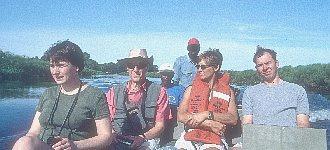 Okavango delta boat trip - the group
Okavango delta boat trip - the group
A very
knowledgeable (and multilingual) black Ben as guide showing the ropes of this
tour to originally-German Julia. Both
about 38, they drove the van and prepared the meals – we all put on weight.
We being myself, Joanne with husband Adam
(both about 32) and Geoff, roughly 68 years old, to make up the numbers.
A generously-sized group – the full complement of
eight tourists would have been somewhat cramped in the bus (a converted
LandCruiser) even though the camping equipment was towed in a trailer.
Okavango delta

Picked up
at the airport, we never saw the capital, Windhoek, until the last day (a nice
place but not one to rave about). Flat
land, dry bushy scrub as we went east through infrequent small townships - the
bush getting gradually greener and taller. Lots of birds - not exactly what I imagined in the "Kalahari
Desert". It was supposed to be the
"rainy season" (which can mean deluges, but normally means a few mm 2
or 3 times in the week) but we were very fortunate - I never unpacked anorac or
umbrella. What no one had realised is
that it's low-water in the Okavango Delta in the rainy season, and high
water later on.
The area is a
landlocked inland sump for the Okavango River that fills with the rains in
Angola around September time. Most of
the land is farmed (cattle, goats) but not intensively (roughly 1 beef cow per 20
hectares). That means relatively little
wildlife, though the Delta is built up to be a wildlife experience.
Also we (I had done almost no reading up
beforehand) imagined wide waterways with reasonable views here, not being
pushed through reed beds, protecting one's face (hence no view) by the mokoro
(long narrow punts) polers.
Not
unpleasant or uninteresting, simply unexpected, as was sitting cramped for
1½-2hrs in mid-afternoon sun. But we
did a few 'game walks' on the islands (solid ground) and saw water buffalo (a
dangerous animal, because unpredictable) and red letchwe (an antelope).
And when Julia went to stand in the shade of
some bushes one time she almost got bowled over by 7 warthogs (a super
animal,
always a pleasure to see) escaping from a huge burrow where they had been
taking a siesta! Sometimes the grass
had been burnt off, either by lightning or human intervention.
Then it was easy to see the fox-sized
jackals trotting about – they're a little grayer than foxes but move in a
similar, though less timid, way. On the
way back we stopped to watch, from a reasonable distance, the hippos erupting
from amongst the water lilies to grab another lungful of air before subsiding
into the relative cool of the water channel again. Had a "swim" (unbelievable contrast with the Galapagos)
– a few minutes dip in shallow murky water amongst hippodung and rotting reeds. But an experience
– one wouldn't know if one didn't go. The contrast of the muggy
heat from the cool of the English winter was quite marked.
Camping in the wetlands

Difficult
to depict the tall broad trees under which we camped for a couple of nights,
with our "bush shower" of a little water dribbled through a small
shower nozzle behind a tarpaulin hung between bushes - just a freshener before
the next application of anti-mosquito spray (though the mosquitos weren't
nearly as uncomfortable as in other areas of the world). A hole-in-the-ground loo with a shovel and
soil to cover one's work of the day, also between bushes, but without the
tarpaulin. Strange, too, the swishing
of the thick grass/reeds on arms and head as we were poled through almost
invisible channels; the nighttime sounds "off" of hippo, lion and
hyena (not so far off either), and the disappointing walks through
(unworked) farmland
hoping to see elephant and not seeing a mouse even, the
sapping heat and the almost complete lack of contact with the
"natives" (not meant pejoratively)
– though we did have a camp fire
where they told a folk story, ably translated by Ben.
I didn't find it too hot there or anywhere else, but sitting
immobile in the mokoro on the breathless
water wasn't as pleasant as lazing on
the deck in the ship's breeze in the Galapagos.
The view wasn't as extensive, either, or perhaps I should say that
the expanse of sky was even greater than on the American trip. When driving towards Etosha one had even
more the impression, perhaps given by the fluffy-topped flat-based clouds, of
the immensity of the heavens wrapping round the small sphere of the earth
– as if one could see over the low-bushed horizon cut in two by the
mirage-wet road.
Tourist trinkets

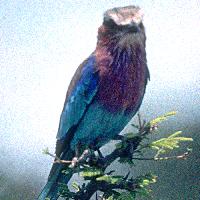 lilac-breasted roller
lilac-breasted roller
On the way
to the Delta we had stopped off at a sort of self-help co-op where the Bushmen
used to make cochineal and still make trinkets such as bracelets, in
traditional manner, for tourists. However, the enterprise has more or less gone to the dogs in the last
year now that there are no foreign NGO workers to chivvy the locals to keep
going. It took the west several hundred
years to get to a market economy, so it's hardly surprising the
semi-nomadic
Bushmen of a hot, arid (and hence
energy-sapping) climate can't see the point
of merchandising. But the traditionally
soft leather they work with is from the desert
animals (it's what the Bushman
wears, if anything)
and the beads are of
ostrich egg shell (they cache water in
ostrich eggs) chipped by hand and bored for the thread by hand-held
bow-drill. I don't suppose the native
Bushmen wear many ornaments, but those we saw were simple, natural and
ungaudy. They had some nice simple
basketwork and paintings too, but somehow not so appealing. It's important to visit such "primitive"
cultures around the world; think about them; decide what essential points of
these cultures their peoples should preserve, but also realise that if they
can't evolve quickly enough then they must disappear. "Bottled" immobile cultures cannot and should not
survive.
It becomes drier

Leaving
the Delta, going north and west, the landscape became drier, but no less flat
or green. The kilometres we travelled
became very noticeable - if it hadn't been for bird-spotting it would have been
pretty boring (Geoff slept well bouncing in the van but very badly at night - I
shared a tent with him). We spent a
night on the campsite of a farm owned by 3rd generation Germans (a lot in the
area - they speak a surprisingly pure language - this used to be German SW
Africa), getting invited, after much
hinting and cajoling by Julia, to a
neighbourhood party, followed the next morning by a tour of the cattle farm
(800 cattle on 160km2). By
now the scenery was drier, with acacia (thornbush) trees more sparsely spaced,
sometimes with individual weaver-bird nests and sometimes with huge
sociable-weaver nests filling the boughs.
I had read about the area over the years (Laurens van de Post, etc.) but
never "seen" it correctly in my mind.
Up by Rundu we stayed at a lodge on the banks of the Okavango and
had dinner in the restaurant
sitting at a table at last – I wasn't brought up to
eat off my knees in front of the tele. And I had the tent to myself
– all the others took a room for the
night. Am not very good at sleeping
with others, but I'm prepared to try! Some rain the next morning, but we
were in the bank at the time standing in a lengthy
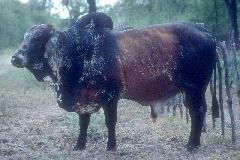 prize bull
prize bull
queue – bank, post office, supermarket, always queues. They have supermarts as we do (in the towns
and bigger villages), quite well stocked. Most of the produce comes from S. Africa; meat, fruit and veg as well,
which must be a drain on Namibia's wealth.
Etosha safari

And thence
to the Etosha National Park - probably the high point of the trip, though only
3 nights
(and perhaps not as exciting as the Kruger Park in S.
Africa). For a salt pan region it has
immense herds of beautifully-coloured springboks (the young were playing at
running and "sprotting"), zebra and giraffe (doing their
"necking" or ritualised stand-off behaviour) – that's a beautiful,
elegant and impressive animal. A herd
of dust-covered elephant, about 30 with young, ambling through the bush -
others scooping trunkfuls of water at a watering-hole. Some lion too - what a snoringly boring
animal as it sleeps, perhaps 8 or 9 in a group, in the shade of a thorn
tree. Hyena, jackels,
wildebeest,
together with birds such as kori bustard
and ostrich, all there giving life to
this hot, rain-forsaken, heat-hazy land. The young springbok we saw sprotting in the evening were bounding in the
air out of line as regards to their running track,
showing the blaze of their
laid-back tail, a defensive behaviour apparently designed to impress preying
cheetah how fit and fast they are. One
youngster was running alongside our van at over 50kph for over 400m - but that
wouldn't be fast enough to outrun any cheetah if it were really hungry. Had been looking forward to seeing cheetah
or leopards, but as it turned out we saw neither. I'll have to go again! Am
not sure I'd do that though; at least, it's not a country I shall rush back
to.
Seals and dunes

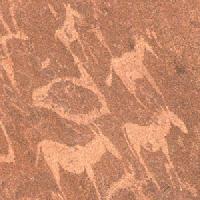 rock engravings
rock engravings
The park
was the beginning of the drier, western, section of the trip, and by the
afternoon we left we were already among rocky hills. This was where we saw a large number of petroglyphs, amazingly
well-preserved even though there had been major rockfall since they were carved
a long time ago (no dates given). Quite
impressive. A day-long dirt-road drive
to get round the Brandberg massif (about 2000m high), towards the end of which was
empty gravel desert. The sea mists come
some 40-50km inland but there's no precipitation as such – any animals and
plants have adapted to use the frequent mist. Fortunately there was none the day we visited the fur seal colony at
Cape Cross – hundreds of them at a particular promontory and thousands of black
babies, furrier than I remember them in the Galapagos. Smelt rather strongly as we had our late
lunch by the ocean – nice to see the water. That evening and the following morning we had in Namibia's second city,
Swakopmund. A Bournemouth of sorts, but
smaller, and the major resort for Namibians. Wide streets, low buildings, a prom and some pleasant cafés where one
could while away an hour or so. A
sleepy outback town.
A long afternoon
through the gravel and low sparsely green hills to reach Sossusvlei, a
region of sand dunes. You certainly have to travel to see
the sights here. Two nights
at this gentle site with our tents pitched under a huge camelthorn tree.
Over 20 of these trees, a fair distance
between them so giving a bit of privacy to each.
I wasn't getting to
sleep easily so had plenty of chance to see, by
moonlight, male springbok fighting for mates and oryx with their long
straight horns come right up to the low wall behind which we camped. Not quite as magical as the owl and badger I
saw in Germany (so why go to Africa? !) but special all the same. These animals, together with the ostrich,
don't need standing water – they can survive for years on
the vegetation,
which I thought was plentiful, given that this is supposed to be desert.
 land of dunes
land of dunes
A slog up a 120m high dune the next morning,
to see the sunrise
(45min drive to get there first, plus 30min climb), but our
drivers hadn't seen that there was cloud to obscure the view – which
wouldn't have been sensational anyway. But then
a good walk, guided by a park specialist, through the dune area looking at
animal spoor and plants, together with an explanation of how the dunes were
formed, etc. Very pleasant in all this
western part not to be worried by flies and mosquitos - makes sitting by the
campfire a bit more comfortable. We
arrived in Windhoek, the capital, on a superb warm clear Sunday afternoon.
The shops were closed, not that I wanted
anything, so I sat in the shade of the gardens of the parliament buildings
watching the lizards catch huge flying ants – they move at a phenomenal
speed. A good comprehensive trip, really.
I think I can recommend it to you, even
though there's so much travelling and so little doing.










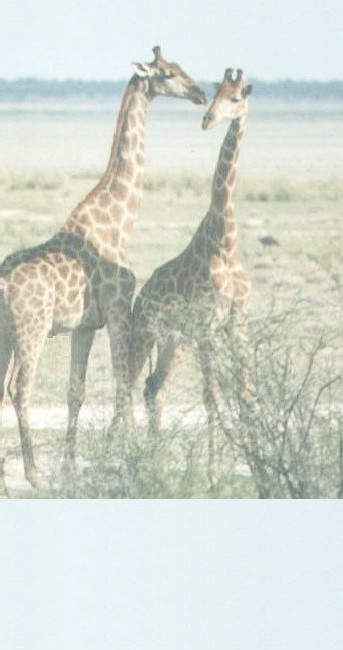

 Okavango delta boat trip - the group
Okavango delta boat trip - the group



 lilac-breasted roller
On the way
to the Delta we had stopped off at a sort of self-help co-op where the Bushmen
used to make cochineal and still make trinkets such as bracelets, in
traditional manner, for tourists. However, the enterprise has more or less gone to the dogs in the last
year now that there are no foreign NGO workers to chivvy the locals to keep
going. It took the west several hundred
years to get to a market economy, so it's hardly surprising the
semi-nomadic
Bushmen of a hot, arid (and hence
energy-sapping) climate can't see the point
of merchandising. But the traditionally
soft leather they work with is from the desert
animals (it's what the Bushman
wears, if anything)
lilac-breasted roller
On the way
to the Delta we had stopped off at a sort of self-help co-op where the Bushmen
used to make cochineal and still make trinkets such as bracelets, in
traditional manner, for tourists. However, the enterprise has more or less gone to the dogs in the last
year now that there are no foreign NGO workers to chivvy the locals to keep
going. It took the west several hundred
years to get to a market economy, so it's hardly surprising the
semi-nomadic
Bushmen of a hot, arid (and hence
energy-sapping) climate can't see the point
of merchandising. But the traditionally
soft leather they work with is from the desert
animals (it's what the Bushman
wears, if anything)

 prize bull
queue – bank, post office, supermarket, always queues. They have supermarts as we do (in the towns
and bigger villages), quite well stocked. Most of the produce comes from S. Africa; meat, fruit and veg as well,
which must be a drain on Namibia's wealth.
prize bull
queue – bank, post office, supermarket, always queues. They have supermarts as we do (in the towns
and bigger villages), quite well stocked. Most of the produce comes from S. Africa; meat, fruit and veg as well,
which must be a drain on Namibia's wealth.


 rock engravings
The park
was the beginning of the drier, western, section of the trip, and by the
afternoon we left we were already among rocky hills. This was where we saw a large number of petroglyphs, amazingly
well-preserved even though there had been major rockfall since they were carved
a long time ago (no dates given). Quite
impressive. A day-long dirt-road drive
to get round the Brandberg massif (about 2000m high), towards the end of which was
empty gravel desert. The sea mists come
some 40-50km inland but there's no precipitation as such – any animals and
plants have adapted to use the frequent mist. Fortunately there was none the day we visited the fur seal colony at
Cape Cross – hundreds of them at a particular promontory and thousands of black
babies, furrier than I remember them in the Galapagos. Smelt rather strongly as we had our late
lunch by the ocean – nice to see the water. That evening and the following morning we had in Namibia's second city,
Swakopmund. A Bournemouth of sorts, but
smaller, and the major resort for Namibians. Wide streets, low buildings, a prom and some pleasant cafés where one
could while away an hour or so. A
sleepy outback town.
rock engravings
The park
was the beginning of the drier, western, section of the trip, and by the
afternoon we left we were already among rocky hills. This was where we saw a large number of petroglyphs, amazingly
well-preserved even though there had been major rockfall since they were carved
a long time ago (no dates given). Quite
impressive. A day-long dirt-road drive
to get round the Brandberg massif (about 2000m high), towards the end of which was
empty gravel desert. The sea mists come
some 40-50km inland but there's no precipitation as such – any animals and
plants have adapted to use the frequent mist. Fortunately there was none the day we visited the fur seal colony at
Cape Cross – hundreds of them at a particular promontory and thousands of black
babies, furrier than I remember them in the Galapagos. Smelt rather strongly as we had our late
lunch by the ocean – nice to see the water. That evening and the following morning we had in Namibia's second city,
Swakopmund. A Bournemouth of sorts, but
smaller, and the major resort for Namibians. Wide streets, low buildings, a prom and some pleasant cafés where one
could while away an hour or so. A
sleepy outback town.
 land of dunes
A slog up a 120m high dune the next morning,
to see the sunrise
(45min drive to get there first, plus 30min climb), but our
drivers hadn't seen that there was cloud to obscure the view – which
wouldn't have been sensational anyway. But then
a good walk, guided by a park specialist, through the dune area looking at
animal spoor and plants, together with an explanation of how the dunes were
formed, etc. Very pleasant in all this
western part not to be worried by flies and mosquitos - makes sitting by the
campfire a bit more comfortable. We
arrived in Windhoek, the capital, on a superb warm clear Sunday afternoon.
The shops were closed, not that I wanted
anything, so I sat in the shade of the gardens of the parliament buildings
watching the lizards catch huge flying ants – they move at a phenomenal
speed. A good comprehensive trip, really.
I think I can recommend it to you, even
though there's so much travelling and so little doing.
land of dunes
A slog up a 120m high dune the next morning,
to see the sunrise
(45min drive to get there first, plus 30min climb), but our
drivers hadn't seen that there was cloud to obscure the view – which
wouldn't have been sensational anyway. But then
a good walk, guided by a park specialist, through the dune area looking at
animal spoor and plants, together with an explanation of how the dunes were
formed, etc. Very pleasant in all this
western part not to be worried by flies and mosquitos - makes sitting by the
campfire a bit more comfortable. We
arrived in Windhoek, the capital, on a superb warm clear Sunday afternoon.
The shops were closed, not that I wanted
anything, so I sat in the shade of the gardens of the parliament buildings
watching the lizards catch huge flying ants – they move at a phenomenal
speed. A good comprehensive trip, really.
I think I can recommend it to you, even
though there's so much travelling and so little doing.